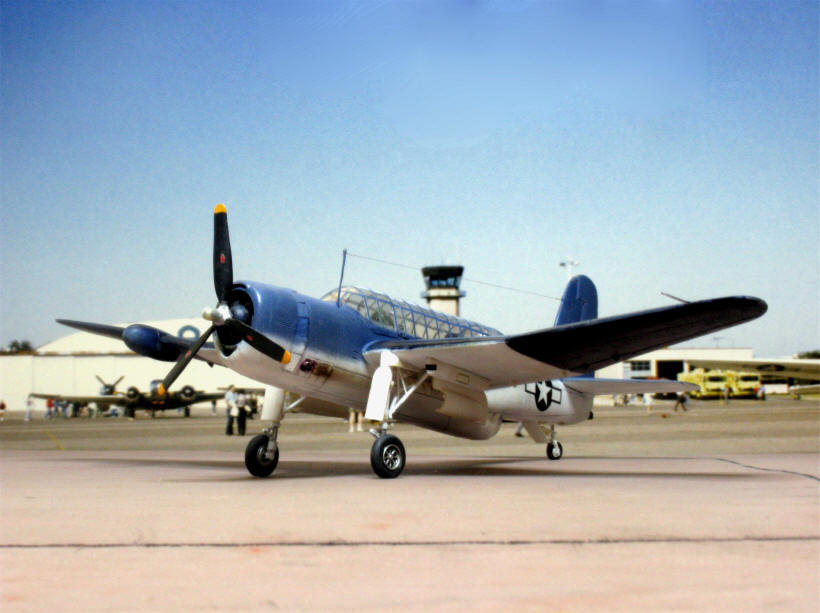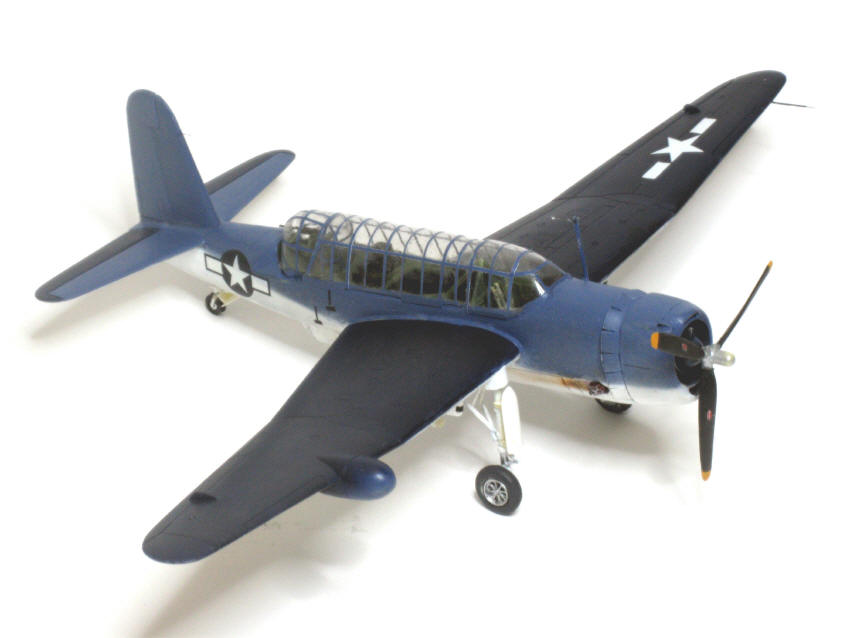|
|
AM-1 Mauler and TBY-2 Sea Wolf by Czech Master Resin
| Models by Wilfried Eck | ||
|
||
|
AM-1 Mauler and TBY-2 Sea Wolf by Czech Master Resin |
"The runner ups"
| Forgotten today both aircraft once had great potential for winning their respective competition. 1940 the Vought XTBY-1 "Sea Wolf" against the XTBF-1 "Avenger" by Grumman, and 1943 Martin's XAM-1 "Mauler" against Douglas' XAD-1 "Skyraider". |
| TBY-2: Though almost similar in its layout the Sea Wolf was technically far superior to the XTBF-1 Avenger (i.e. a single lever operated all functions needed for take off, flight, dive and landing), heavily armed (3 machine guns internally, two pods with two MG's optionally externally), radar pod, and last not least a whole 80 kts faster. As safeguard against the failure of the TBF the Navy ordered 1,000 TBY-1 but contracted Consolidated Vultee for further development and production as Vought was entirely occupied with the production of the F4U Corsair. When Vultee engineers used to construct buses and trucks tried to improve the TBY even further the whole thing went downhill. Even more so when the prototype crashed and the production hall was severely damaged in a fire. In the outcome after many tests to get the automtic working the first production TBY-2's were delivered in 1945 when there was no more use for them. Most of the TBY's went directly from Vultee to the scrap heap. |
|
AM-1: For the new Navy category of "Attack" Douglas proposed its XAD-1 Skyraider, Martin its XAM-1 Mauler. Both were driven by massive engines of 2,800 resp. 3,000 hp to carry the required load of 4,500 lbs. (4.082 kg); speed 500 kmh, range about 3,000 km (XAD-1 a little bit less, XAM-1 a little bit more). What made the Mauler loose out was its inferior aircraft carrier suitability. When getting the "cut" power reduction, dropping the nose and then pulling control stick full back to get the tail down was necessary, but in the Mauler the nose stayed down, making carrier landings hazardous. So despite some otherwise pluses on the AM-1 side pilots preferred the AD-1. Only 139 AM-1 were built. |
|
|
|
Kit review: Both are resin kits, the only exception being the cockpit hoods, and in case of the AM-1 an optional main landing gear in white metal. Decals show markings for (TBY-2) aircraft from VA-175/176, resp. (AM-1) Naval Test Center and VA-174 (tail code R), also some stencils; both for aircraft in Glossy Sea Blue. Thin and with excellent adherence. Fit of parts is also excellent. But where these kits really excel is the representation of smaller details. Beginning empennage and wings in scale thickness (a more fitting term would be thinness) as well as sharp trailing edges to rocket fins in approximately scale thickness (the term "thinness" would be better). Incredible, something that has to be seen! Further armament comprises two gun pods in case of the TBY-2 and a complete set of said rockets, torpedoes and bombs for the AM-1. Naturally also with fins of the finest. Also seldom seen on other kits are a grooved carrier type tailwheel and a plough (plow) shaped tip of the landing hook. The AM-1 kit takes into account that the Mauler sported square or round tipped airscrews, but leaves open which one fits to which markjng variant (rounded tips for both). |
|
The so called "detailing" - representation of panel lines - is up to 1/72 standard (though in my opinion this kind of detailing is exaggerated, especially in 1/72 or smaller scale; more so when the real thing had overlapping panels). |
|
The cockpit interior can be described fairly detailed, leaving some room for adding details, especially some seat straps (running from the frame above the seat and in case of the AM-1 also the control stick for the automatic in front of the instrument panel). The same goes for the gun turret of the TBY-2 (I added a home made ammunition belt). Falling a little bit off is the representation of the AM-1 landing gear. It's unique insofar as the lower door was held by two horizontal bars with U-profiles. Omitting this profile is acceptable in this scale (though CMR could have done it), but the whole affair comes out too massive, especially in the white metal variant. |
|
Due to to an excellet fit of parts assembly is straightforward, in case of the mid wing TBY-2 wings and horizontal stabilisers are to rest in recesses which results in such a good fit that putty isn't needed at all. |
|
Alterations: Though both kits are correct and can be assembled as they are, in my case some refinements deemed appropriate. The kit canopies though thin and clear (one spare provided) have struts which in my opinion protrude too much. That's the way modelers want it to be I was told by CMR, but in my opinion such struts shown in original size would be logs. In reality the clear parts rested in recessions and were covered by strips of thin sheet metal. Too thin to be shown in 1/72 scale. Former engineers did know aerodynamics and drag reduction. So - as usual - I made mine including the tail turret myself (as described elsewhere). Strut representation by thin strips of suitably coloured decal leftovers (see photos below). Antenna mast shaped PVC (doesn't break so easily), wire by some strands of stocking thread. As the AM-1 thin resin cannon are prone to break I substituded barrels made from stretched cotton buds. Naturally a "flying" Mauler needed a pilot (assembled from various parts) and a spinning propeller. As the kit propeller axle was a little bit short the solution was to make the spinner from suitably shaped PVC (axle a pin from the stocks of my wife) and drill holes where the separated propeller blades were to go in. |
| Apart from the greenhouse canopy and the tail turret (kit part very thin at the top) I altered the TBY-2 by adding slightly opened cooling flaps (cut off cowling, file rear to wedge shaped form, add a ring of thin plastic and cement slightly bent rectangles), and exhausts from thin Evergreen tubes. |
|
Paint: For "Glossy Sea Blue" one could use ready mixed paint, but due to scale effect this would result in a finish much too dark. To get the required blue-black colour (NEVER simply dark blue!) I simply mixed dark blue and black until the right "midnight blue" tint was obtained. In case of the Sea Wolf I decided to make it a different look, to say in the colours of the prototype, differing from official paint regulations. Though the upper sides of the wings were standard semi gloss "Sea Blue", this colour was also seen on the upper sides of the elevators and the lower sides of the outer wings. Undersides otherwise "Non Specular Insignia White". In black and white photos of the original aircraft the fuselage, vertical fin and horizontal ones appear in some kind of blueish gray. Steve Ginter states "Intermediate Blue", in my opinion it looks more like the then standard "Blue Gray". (Not yet standardized each manufactorer had his own recipe). In the outcome a hue between blue and gray (Side note: Midway time a/c had this colour too, and unlike some models it definitely wasn't stone gray or so). - Cockpit interiors: AM-1 everything semi gloss black, TBY-2 no idea, not a single example survived. Photos show a middle gray tone so some kind of green (as was customary these days) should not be too wrong. |
| No "weathering" or "ageing" as both aircraft were held in pristine condition (Navy style to prevent corrosion). |
|
Summary: Though not produced in large numbers, both are very fine kits, far away from some crude short run kits. Entirely up to the usual standard. In some points the finest ever seen. |
|
|
|
|
|
|
 |
 |
|
|
Arrows show alterations, kit canopy on top
General thoughts and tips for modeling see "Modeling ABC"